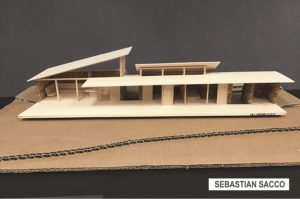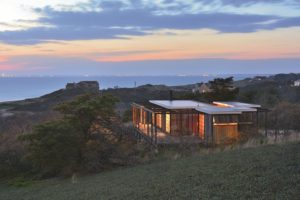“It is unusual for a high school to have an architecture program,” says Peter McMahon, the founding director of the Cape Cod Modern House Trust (CCMHT) and co-author of Cape Cod Modern: Midcentury Architecture and Community on the Outer Cape. Five years ago, the architect Richard Tichnor was given free rein by Nauset Regional High School to create a curriculum for students interested in architecture.

“We started the first year with a single Intro to Architecture class and five students,” Tichnor says. “Over the years, we’ve grown to four classes: Arch 1, Arch 2, advanced, and, last year, we added honors level. Having the freedom to create my own curriculum has afforded me the opportunity to spend a lot of one-on-one time with each student and to help them discover where their strengths and interests lie.”
Two graduating Nauset seniors are planning to continue their architecture studies at top universities this fall. Their work on a semester-long project to redesign the Hatch House in Wellfleet — a modernist gem overlooking Cape Cod Bay that was restored by CCMHT — inspired the trust to create an annual Young Architect Award.
“These kids are quite amazing,” McMahon says. “I do a lot of projects with college-age kids in architecture school, and I was very surprised with the quality of the work they came up with.”

Sebastian Sacco won the first Young Architect Award for his remarkable drawings and model of the Hatch House redesign, which was presented at a socially distant ceremony at the Hatch House last week. “He has a great eye and has always been a very good designer,” Tichnor says.
Sacco was one of the first students in Tichnor’s program and went on to take six semesters of course work. His interest in Cape Cod modern houses was instrumental in bringing McMahon into the Nauset program. “I was already inspired by the architectural history of Cape Cod and the Cape Cod Modern House Trust before I got [McMahon’s] book,” Sacco says.
Tichnor put Sacco in touch with McMahon, who took him to visit the Marcel Breuer House in Wellfleet. “I loved how well the house fit into the site,” Sacco says, “and the way modernism blends with vernacular ideas about what a ‘Cape house’ should look like.”
In 2019, Sacco’s interest in the CCMHT houses led Tichnor to devise a semester-long project for his class in collaboration with McMahon. “The idea was to take the concept of the Hatch House, which is modular boxes, and reimagine it with the same number of modules — 18 interior, 18 exterior — and the same basic grid,” McMahon says. Tichnor had each student do a set of drawings and a quarter-inch-scale design model.

Sacco’s winning concept focused on stretching the house out and creating exterior access with a deck. “I had a linear axis that ran through the entire length of my design,” he says, “which is different from what the Hatch House looks like now, with modules that face each other.”
This fall, Sacco will begin his studies in architecture at Pratt Institute in Brooklyn, N.Y. “I’m excited to hone my skills,” he says, adding that he’s especially interested in designing houses that are environmentally friendly: “That kind of activism is something I am passionate about.”
Sophie Friend, who received honorable mention in the competition, followed her interests in a different direction. As a result of Tichnor’s classes, Friend developed “almost an obsession” with the history of architecture and architectural sites throughout the world, she says. “My favorite building is St. Basil’s Cathedral in Moscow — I did a presentation in class and want to thank my classmates, because I talked for an hour about Russian architecture from 400 B.C. to 2019.”
Friend’s family’s heritage inspired her next to research the history of African architecture. “I’m fourth-generation Cape Verdean,” she says. “I feel that people write off African architecture, because they compare it to gothic cathedrals, for example. I believe that one kind of architecture is not better than another. Africa actually has some of the oldest cities in the world. They are really amazing and deserve to be studied.”
When McMahon started to work with Tichnor’s class, Friend impressed him with her research on the history of Cape Cod modern houses. “Sophie is very academic,” he says. Friend went on to work with McMahon on her senior project, creating the fully illustrated and hand-lettered book, An Overview of Architecture.
This fall, Friend will study art history, architectural history, and design at Smith College. She hopes in the future to work on protecting lesser known heritage sites in countries prone to conflict.

“Well-known cultural sites are already being protected,” she says, “but less well-known, day-to-day architecture is just as important.” Friend cites as an example the painted houses of the Ndebele people, who live in South Africa and Zimbabwe. “They are beautiful houses with murals covering the outside,” she says. “The mother paints her home, then she passes down that pattern to her daughter, who paints it on her home, and so on.”
Friend hopes that preserving existing homes will also have an effect on climate change. “The building industry creates 30 percent of carbon emissions,” she says. “It has been proved that renovating and restoring buildings is 10 times more effective in reducing environmental damage than tearing down and building new. If we can work on conserving, that will help us in our climate change battle.”



